1. Torre LA, Bray F, Siegel RL, Ferlay J, Lortet-Tieulent J, Jemal A. Global cancer statistics, 2012. CA Cancer J Clin. 2015; 65:87–108. PMID:
25651787.

2. Jung KW, Won YJ, Oh CM, Kong HJ, Lee DH, Lee KH, et al. Cancer statistics in Korea: incidence, mortality, survival, and prevalence in 2014. Cancer Res Treat. 2017; 49:292–305. PMID:
28279062.

3. Park EH, Min SY, Kim Z, Yoon CS, Jung KW, Nam SJ, et al. Basic facts of breast cancer in Korea in 2014: the 10-year overall survival progress. J Breast Cancer. 2017; 20:1–11. PMID:
28382089.

5. Howlader N, Noone AM, Krapcho M, Miller D, Bishop K, Altekruse SF, et al. SEER cancer statistics review, 1975-2013. National Cancer Institute;Accessed May 15th, 2017.
http://seer.cancer.gov/csr/1975_2013.
6. Kemeny MM, Peterson BL, Kornblith AB, Muss HB, Wheeler J, Levine E, et al. Barriers to clinical trial participation by older women with breast cancer. J Clin Oncol. 2003; 21:2268–2275. PMID:
12805325.

7. Hutchins LF, Unger JM, Crowley JJ, Coltman CA Jr, Albain KS. Underrepresentation of patients 65 years of age or older in cancer-treatment trials. N Engl J Med. 1999; 341:2061–2067. PMID:
10615079.

8. Lewis JH, Kilgore ML, Goldman DP, Trimble EL, Kaplan R, Montello MJ, et al. Participation of patients 65 years of age or older in cancer clinical trials. J Clin Oncol. 2003; 21:1383–1389. PMID:
12663731.
9. Bouchardy C, Rapiti E, Fioretta G, Laissue P, Neyroud-Caspar I, Schäfer P, et al. Undertreatment strongly decreases prognosis of breast cancer in elderly women. J Clin Oncol. 2003; 21:3580–3587. PMID:
12913099.

10. Owusu C, Lash TL, Silliman RA. Effect of undertreatment on the disparity in age-related breast cancer-specific survival among older women. Breast Cancer Res Treat. 2007; 102:227–236. PMID:
17004115.

11. Muss HB, Woolf S, Berry D, Cirrincione C, Weiss RB, Budman D, et al. Adjuvant chemotherapy in older and younger women with lymph node-positive breast cancer. JAMA. 2005; 293:1073–1081. PMID:
15741529.

12. Freyer G, Lortholary A, Delcambre C, Delozier T, Piot G, Genin F, et al. Unexpected toxicities in elderly patients treated with oral idarubicin in metastatic breast cancer: the GINECO experience. Clin Oncol (R Coll Radiol). 2004; 16:17–23. PMID:
14768751.

13. Hurria A, Togawa K, Mohile SG, Owusu C, Klepin HD, Gross CP, et al. Predicting chemotherapy toxicity in older adults with cancer: a prospective multicenter study. J Clin Oncol. 2011; 29:3457–3465. PMID:
21810685.

14. Extermann M, Boler I, Reich RR, Lyman GH, Brown RH, DeFelice J, et al. Predicting the risk of chemotherapy toxicity in older patients: the Chemotherapy Risk Assessment Scale for High-Age Patients (CRASH) score. Cancer. 2012; 118:3377–3386. PMID:
22072065.

15. Freyer G, Braud AC, Chaibi P, Spielmann M, Martin JP, Vilela G, et al. Dealing with metastatic breast cancer in elderly women: results from a French study on a large cohort carried out by the ‘Observatory on Elderly Patients’. Ann Oncol. 2006; 17:211–216. PMID:
16291586.

16. Biganzoli L, Wildiers H, Oakman C, Marotti L, Loibl S, Kunkler I, et al. Management of elderly patients with breast cancer: updated recommendations of the International Society of Geriatric Oncology (SIOG) and European Society of Breast Cancer Specialists (EUSOMA). Lancet Oncol. 2012; 13:e148–e160. PMID:
22469125.

17. Hashimoto K, Yonemori K, Shimizu C, Hirakawa A, Yamamoto H, Ono M, et al. A retrospective study of the impact of age on patterns of care for elderly patients with metastatic breast cancer. Med Oncol. 2011; 28:434–440. PMID:
20354821.

18. Debled M, Madranges N, Mertens C, Durand M, Brouste V, Brain E, et al. First-line chemotherapy for metastatic breast cancer in patients ≥75 years: a retrospective single-centre analysis. Crit Rev Oncol Hematol. 2011; 80:171–179. PMID:
21036058.

19. Muss HB, Berry DA, Cirrincione CT, Theodoulou M, Mauer AM, Kornblith AB, et al. Adjuvant chemotherapy in older women with early-stage breast cancer. N Engl J Med. 2009; 360:2055–2065. PMID:
19439741.

20. Garg P, Rana F, Gupta R, Buzaianu EM, Guthrie TH. Predictors of toxicity and toxicity profile of adjuvant chemotherapy in elderly breast cancer patients. Breast J. 2009; 15:404–408. PMID:
19508671.

21. D'hondt R, Paridaens R, Wildiers H, Pauwelyn K, Thomas J, Dumez H, et al. Safety and efficacy of weekly docetaxel in frail and/or elderly patients with metastatic breast cancer: a phase II study. Anticancer Drugs. 2004; 15:341–346. PMID:
15057137.
22. ten Tije AJ, Smorenburg CH, Seynaeve C, Sparreboom A, Schothorst KL, Kerkhofs LG, et al. Weekly paclitaxel as first-line chemotherapy for elderly patients with metastatic breast cancer. A multicentre phase II trial. Eur J Cancer. 2004; 40:352–357. PMID:
14746852.

23. Del Mastro L, Perrone F, Repetto L, Manzione L, Zagonel V, Fratino L, et al. Weekly paclitaxel as first-line chemotherapy in elderly advanced breast cancer patients: a phase II study of the Gruppo Italiano di Oncologia Geriatrica (GIOGer). Ann Oncol. 2005; 16:253–258. PMID:
15668279.

24. Biganzoli L, Coleman R, Minisini A, Hamilton A, Aapro M, Therasse P, et al. A joined analysis of two European Organization for the Research and Treatment of Cancer (EORTC) studies to evaluate the role of pegylated liposomal doxorubicin (Caelyx) in the treatment of elderly patients with metastatic breast cancer. Crit Rev Oncol Hematol. 2007; 61:84–89. PMID:
17116400.

25. Bajetta E, Procopio G, Celio L, Gattinoni L, Della Torre S, Mariani L, et al. Safety and efficacy of two different doses of capecitabine in the treatment of advanced breast cancer in older women. J Clin Oncol. 2005; 23:2155–2161. PMID:
15710946.

26. Kaufman PA, Brufsky AM, Mayer M, Rugo HS, Tripathy D, Yood MU, et al. Treatment patterns and clinical outcomes in elderly patients with HER2-positive metastatic breast cancer from the registHER observational study. Breast Cancer Res Treat. 2012; 135:875–883. PMID:
22923238.

27. Du XL, Xia R, Burau K, Liu CC. Cardiac risk associated with the receipt of anthracycline and trastuzumab in a large nationwide cohort of older women with breast cancer, 1998-2005. Med Oncol. 2011; 28(Suppl 1):S80–S90. PMID:
20967512.

28. Chen J, Long JB, Hurria A, Owusu C, Steingart RM, Gross CP. Incidence of heart failure or cardiomyopathy after adjuvant trastuzumab therapy for breast cancer. J Am Coll Cardiol. 2012; 60:2504–2512. PMID:
23158536.

29. Griffiths RI, Lalla D, Herbert RJ, Doan JF, Brammer MG, Danese MD. Infused therapy and survival in older patients diagnosed with metastatic breast cancer who received trastuzumab. Cancer Invest. 2011; 29:573–584. PMID:
21929325.

30. Schneider M, Zuckerman IH, Onukwugha E, Pandya N, Seal B, Gardner J, et al. Chemotherapy treatment and survival in older women with estrogen receptor-negative metastatic breast cancer: a population-based analysis. J Am Geriatr Soc. 2011; 59:637–646. PMID:
21453377.

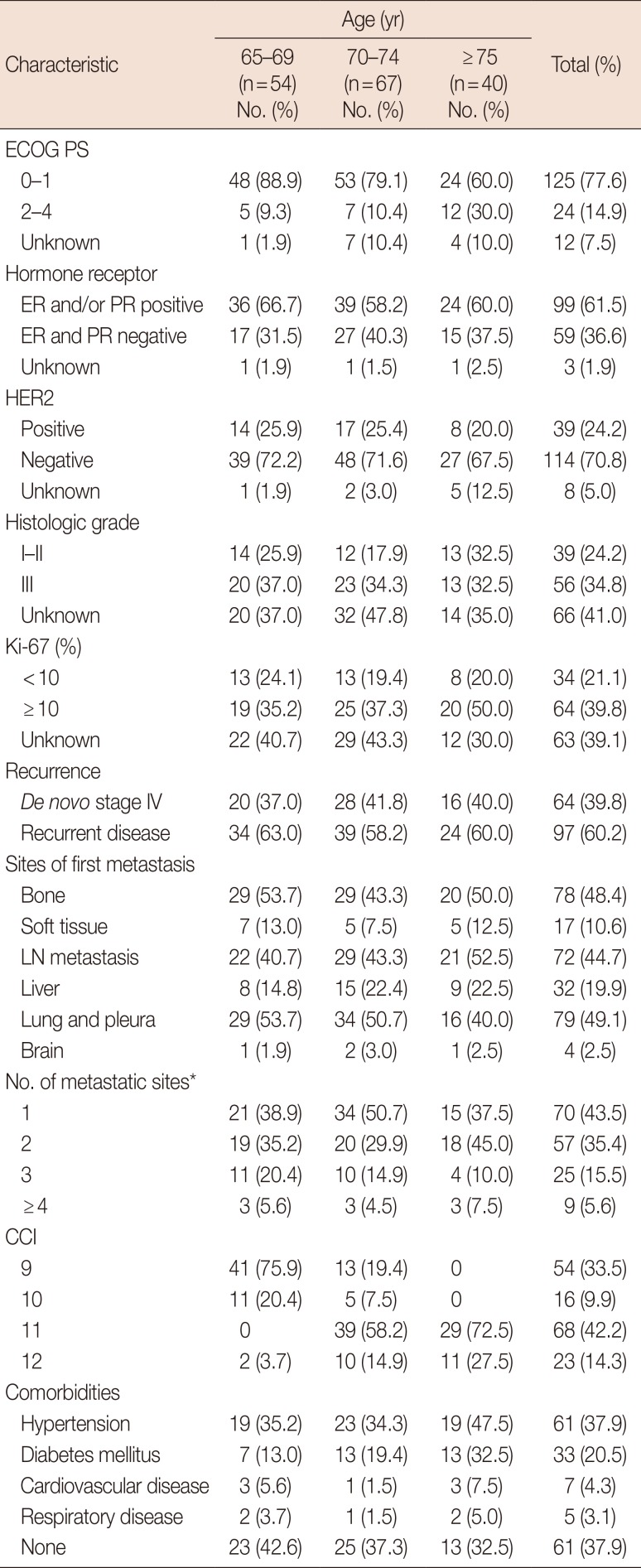
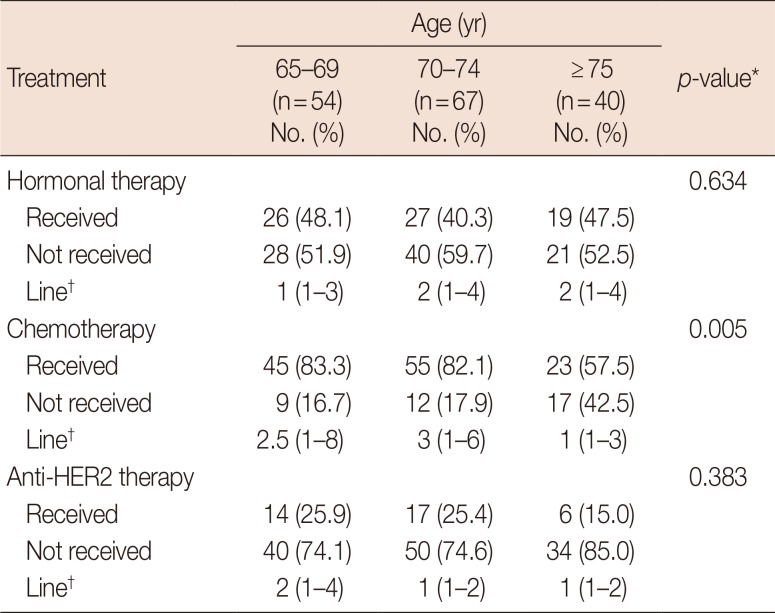
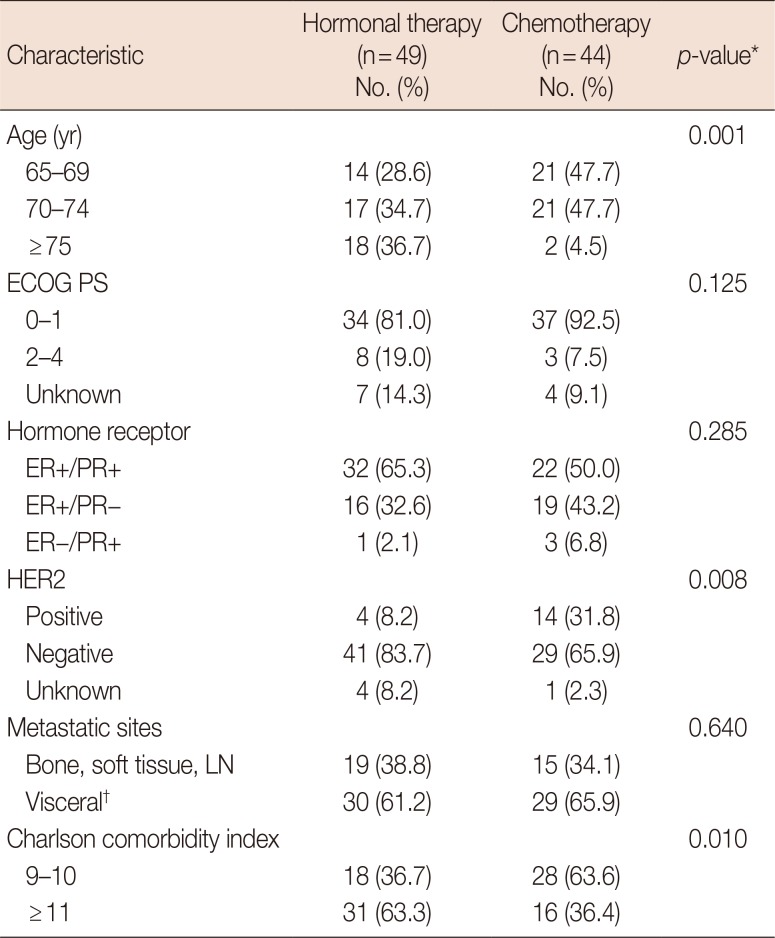
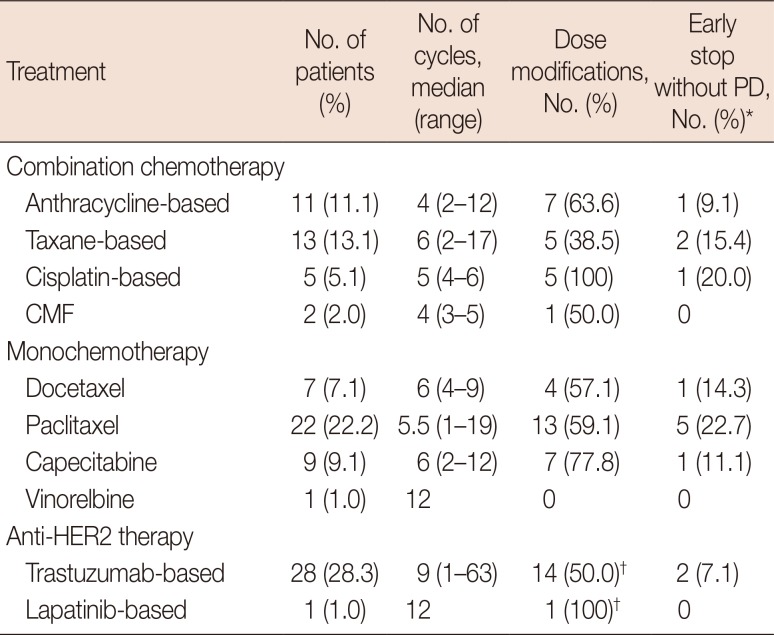

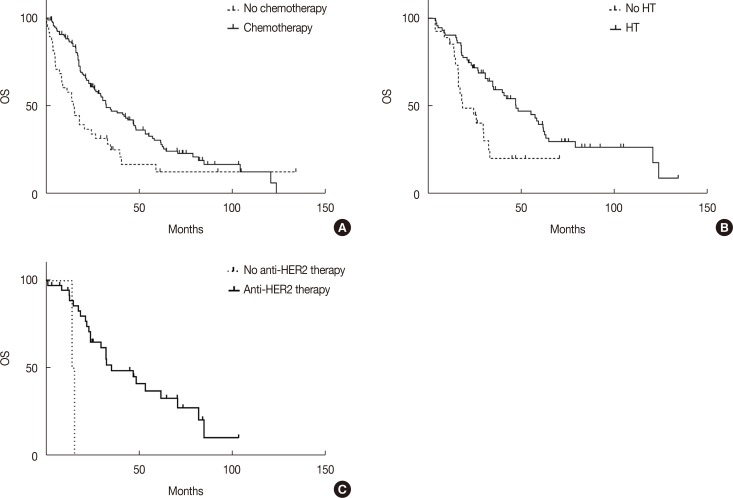
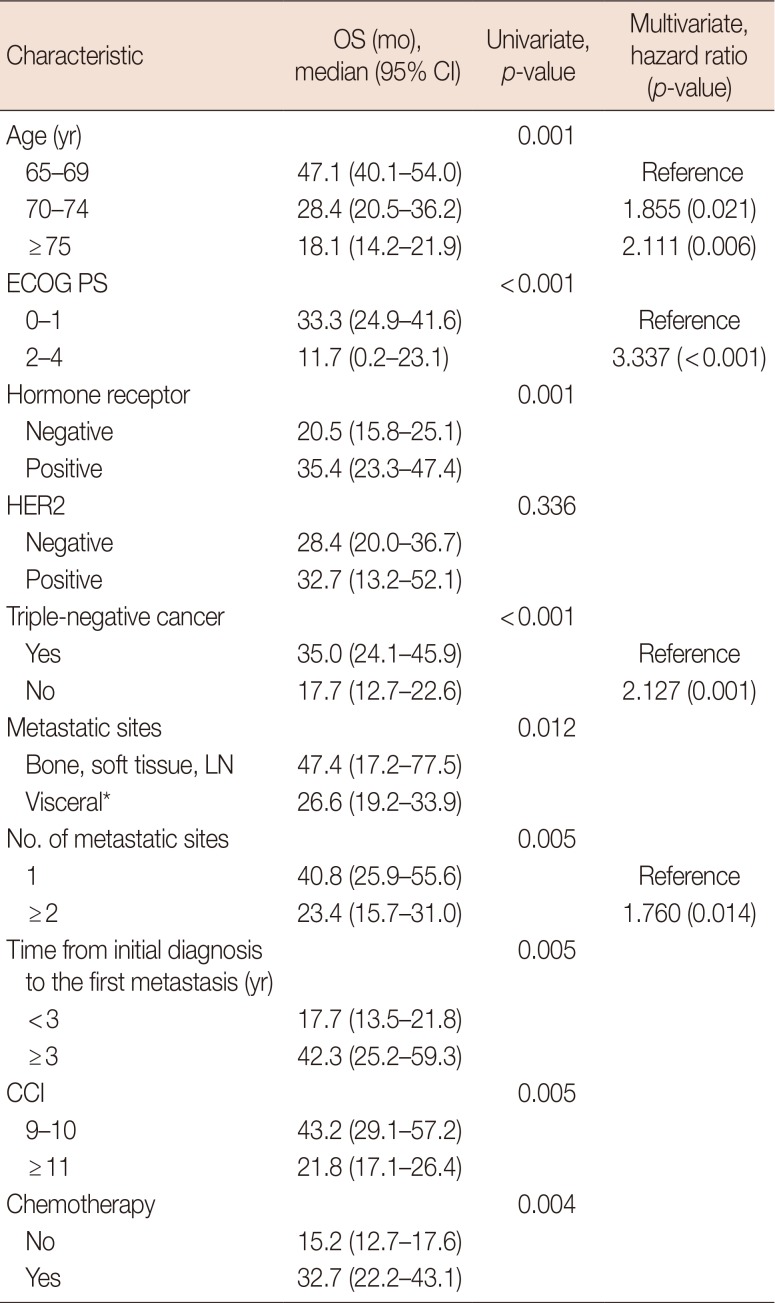




 PDF
PDF ePub
ePub Citation
Citation Print
Print


 XML Download
XML Download